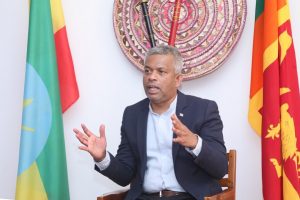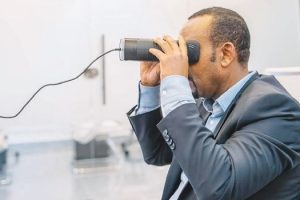
Detlef Mortiz Abebe is a Media Engineer from Germany who has been crisscrossing the world for twenty five years producing science programs for the National Television of Germany. He is currently working on the areas of traffic and innovative solutions on road accidents in Ethiopia. He is our guest to share his life time experience in the areas he is engaged in and different aspects of the country’s socioeconomic development with the articles that The Ethiopian Herald will present in two parts.
Herald: How did Abebe become your last name?
Mortiz: In Germany the women normally take the name from the men but one can make any combination. So, I am married to an Ethiopian woman and I put her name to my name and in Africa most people like this.
Herald: When was it you came to Ethiopia first?
Mortiz: The first time I came to Ethiopia was in 1993. I was in Eritrea to make a report about the referendum. I was also asked to make a travel report about Ethiopia for the most famous TV program in Germany. So, I came here and that was when I met my wife and took her to Germany. Then after, we come three- four times a year to Ethiopia.
I was as well part of the delegation of the first presidential visit of Germany to Ethiopia. We were traveling for ten days with the President in Ethiopia and Eritrea. I had also produced a documentary film about Haile Gebresilassie (the world famous Ethiopian athlete) in 1995. I also wrote a book, which was entitled “Running with Haile” and it was published in six countries.
Herald: What was the content in general?
Mortiz: The content was about stories on athletics ventures of Haile and similar athletes like him who would run long way to school and become successful in athletics. We have millions of people in athletics (Running) and since Haile is a very famous runner around the globe, telling his stories would be telling the stories of many other people in Ethiopia.
Herald: Would you tell us what motivated you to be involved in the road safety and traffic issues in Ethiopia? Also what are your observations?
Mortis: Well, I have been observing that. There is the highest road accident rate in the country. For instance, we have 4,700 people who died from traffic accidents last year only while there are less than one million cars. That means 500 people would die per 100,000 cars. In Germany we have sixty million cars by eighty million people on the streets. For the fact that we are in the middle of Europe, anyone would be passing through Germany including the unregistered tracks from different European countries.
But only five people would pass away from accidents per 100,000 cars. In Ethiopia one would see cars in Addis and on the way to Djibouti and Hawassa. So, the traffic rush in other parts of the country is not that much in comparison to these areas. Hence, the problem is not about the traffic situation or the cars but mostly negligence to obey the law or traffic rules. Traffic jams usually occur because of selfish driving and uncoordinated traffic management as well as bad urban planning.
While standing in traffic, any car uses one litter benzene per an hour. On the other hand, a car needs 2.7 billion USD for fuel annually. Three billion is the profit from the export. So if there remains bad driving and traffic management, the country would be losing billions of USD from unnecessary use of fuel through traffic jams.
On the other hand, if there are twenty thousand minibuses in Addis and one minibus makes hundred stops per day, then there will be two million stops on two or three lanes. That would block the movement in the main traffic times. There may not be enough space for cars that goes out of fuel and they would block one of the three lanes of the road while they are waiting in a nearby gas station. The big mass transportation buses have their own role in such situations.
Ninety nine percent of the population does not drive car. But if people park cars in pedestrian ways, there will be not much space for the pedestrians and that causes additional problem on the traffic system.
Thus, the formidable problem is not the quality of the roads or cars, but irresponsible attitudes of the drivers, which is the result of less professional awareness or knowledge. The training time to obtain driving licenses is not much enough, even for the traffic polices, which is six months.
Herald: How much time does it take in Europe or the country where you are from?
Mortiz: It takes three years with higher school education for the traffic polices.
Herald: Let us continue with the other issues that you would like to mention with the experiences of other countries.
Mortiz: The other issue in Ethiopia is that the punitive measure is not that much educative. Even if there are the best high ways in Europe, when one drives to fast he/she will pay 2,500 Euro. Such amount of money is a monthly income for noble people in Europe. Due to this fact one does not see many people trying to drive above the speed limit. There are cameras and speed measurements and if one is caught the fine is exorbitant. If one also drives on a red light in Germany, he/she will lose his/her driving license for minimum of four years. And if one drives without driving license one won’t see it any more.
The last inconvenience that I would like to mention is inappropriate installation of light systems and traffic signs. If they are installed on positions that does not consider the sunlight effects, they would affect the drivers or pedestrians’ visions and cause road accidents. But above this, there are rules and regulations based on international laws about security distances and many drivers seem to ignore them.
In the US you need to have two meters distance from the car in front of you, when you stop by red light. The reason is that when there is a two meters distance between every car, the cars can start at the same time when the green light comes. The effect of cars standing close to one another in less than two meters distance is one of the road safety or traffic issues that have to be dealt with.
Herald: Thus, what would be the best mechanisms or the creative ways that could solve traffic issues on the country’s current infrastructural status?
Mortiz: The solutions would start from the government’s efforts to create an organized traffic management with the existing infrastructures in the country. It is possible to find the ways that public buses and big track to fuel up their tanks in gas stations in the areas where there are less traffic movements. Building more pedestrian bridges is crucial. The other solution could be implementing educative legal action or punishment systems with improved minimum wage that would motivate the traffic police men to do their jobs right. Scientific installation of light systems and other traffic signs are also very significant for the sake of both drivers and pedestrians.
Herald: So, what are the roles that you are playing so far in these issues?
Mortiz: I came back here to make my contribution in awareness raising and promoting innovative ideas or solutions on road safety and traffic management issues in the country. I am working on a TV show, that was started by my colleague who is a technician and an engineer. There may not be big money and big background but the intention is trying to show the right ways on traffic issues.
While doing so, we have to go through the filming, writing, editing and research activities which take more time and finance. A half hour program is cost intensive, so we may need some sponsors for this. Meanwhile, our focus is on creating awareness and bringing new ideas that could enable the public and governmental actors to deal with the traffic issues in a way that would reduce road accidents as well as the cost of fuel that is wasted because of traffic jams.
The Ethiopian Herald Sunday Edition 8 March 2020
BY HENOK TIBEBU




